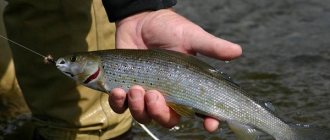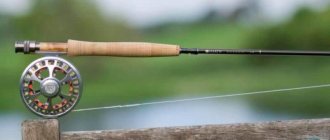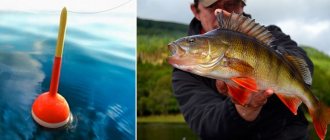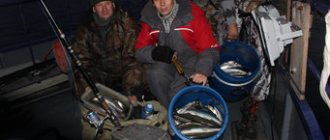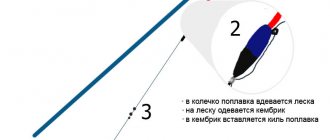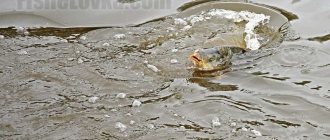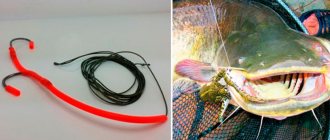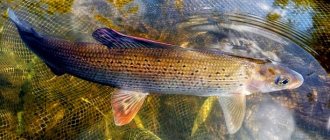Fishing at night is a rather difficult method, which, however, has its fans. Night fishing is possible at any time of the year, but it is more popular in the summer. If you are a beginner, then it is better to try your hand at hunting fish at night in the summer, when you will quickly understand all the intricacies of this tricky business and subsequently be able to apply many of these skills during the day. In general, first of all, night fishing is a time for fishing tales, sitting around the fire and fishing in between drinking tea (or something stronger). But in order to not only have a good time fishing, but also come home with your catch, let’s look at some tricks that will help you and protect you from the dangers of the night.
Features of night fishing
Let's first figure out what advantages there are in this type of fishing:
- You can take any place you like. The bulk of fishermen and vacationers have already left their campsites.
- You don’t have to worry that the fish will see you and your manipulations on the shore through clear water.
- Large fish are less cautious at night, so there is a possibility of catching trophy specimens and bites of small fish are reduced.
- You are not bothered by midges, heat and other “pleasures” of daytime fishing. However, it should be noted that mosquitoes can, on the contrary, become active at night in many bodies of water, so it is better to stock up on repellents.
- At night there is usually no wind or very little wind, which means it will not interfere with casting.
Types of fish suitable for night fishing
Not every fish can be caught in the dark. Of course, first of all you should focus on the ichthyofauna of a particular reservoir. But we can say that all these fish must lead an active nocturnal lifestyle. These fish include:
- Various types of catfish.
- Burbot.
- Some representatives of cyprinids (bream, chub, ide, carp, carp).
- You can catch pike perch from the perch family at night.
- Crucian carp.
Of course, the list can be expanded, but these are the representatives of the underwater world that are most common throughout Russia.
What kind of fish are caught at night?
Which representatives of the aquatic world are active at night on rivers, lakes and other bodies of water? Among all fish species, anglers note the highest activity in perch. This predatory fish with attractive stripes loves to feed at night. Her unprecedented appetite dulls her vigilance, which invariably leads to getting hooked. Also, during the twilight period, bream, crucian carp, burbot, large pike, and record-breaking specimens of carp are readily caught on the fisherman’s bait. These abodes of a reservoir can be located both at depth and near the shore.
The true owner of shallow waters is considered to be pike perch. Fans of night fishing can seriously count on catching it, so they often organize targeted fishing with a selection of gear and bait. If during the daytime pike perch prefers to stay in the depths, then at night, when the water is warmed by the summer sun, it goes out into shallow water. An experienced fisherman distinguishes the approach of pike perch by its characteristic splashes. They resemble a perch approaching the shore, as if the fish were moving in waves, but there was no slurping sound. Almost all aquatic lovers of night feeding bite at sunset, then calm down for a while, and at midnight they again have a feast, which plays into the hands of lovers of night fishing.
Read more:
Catching catfish on the Dniester
Choosing the right tackle
The first thing you should pay attention to when getting ready for night fishing is the choice of gear that will become indispensable assistants and will provide you with half the success. In the dark, they are most often caught using a donkey or spinning rod. If you only use fly rods, then equip it with a special float for night fishing - with a phosphor coating that glows in the dark.
Your tackle should be:
- Maximum sensitive.
- Convenient.
- More durable than during daytime fishing.
With the first two points, everything seems to be clear - you don’t see the tackle, so you will only rely on tactile sensations, so the rod should respond even to weak bites. You should choose gear that will be stronger than for daytime fishing for the same reason - there is a high probability of breakage when fishing and fishing, and you can easily get caught on snags or some kind of debris at the bottom of the reservoir.
Fishing at night
Perhaps the most exciting activity is night fishing. After all, with the onset of twilight, the action begins that gives the fisherman indescribable pleasure. In fact, night fishing is not an easy task. Careful preparation is required, especially in choosing a location. Contrary to the fact that many fishing enthusiasts consider the middle of the reservoir to be a good place, experienced fishermen adhere to their own opinion. Often, fish leave the depths after dark and concentrate in coastal areas where there is abundant vegetation. Therefore, it is not always advisable to make long casts.
At night, fish of quite impressive size can bite, so night fishing requires choosing the appropriate gear. Their variety is very large, which is the individual choice of each fisherman. Many people prefer to use ordinary donka. This is a fairly reliable and simple tackle for night fishing for bream. Often fishermen use a fishing rod with a nod when hunting for large specimens. However, fishing with such gear must be done from a boat. An advantage in night fishing is the rig for pike and other types of predatory fish. Perhaps the most common fishing is using a spinning rod or a float fishing rod. It’s good for night fishing to get tasty bait for fish: maggots, bloodworms, worms, and homemade bait mixtures, specialized baits.
Note to the fisherman! When going night fishing, you should always have spare equipment with you. Moreover, it is important to contain in the arsenal not so much individual elements of equipment, but rather fully assembled equipment. This is explained by the fact that at night it is quite inconvenient to knit broken hooks, leashes, feeders and other elements. To attach them, light is needed, and its glare can scare away fish.
Other useful helpers
When going night fishing on a river or lake, pay much more attention to your preparations than when fishing during the day. Not only your safety and fishing success, but also the safety of your partners depends on high-quality and correct equipment. The use of faulty equipment, defective accessories, or the absence of any required attributes is not allowed.
The most important, even mandatory item is a flashlight or some other light source. The most common assistants are headlamps, but it is also better to have a hand-held device for them. Be sure to check their serviceability and stock up on an extra set of batteries.
In addition to the flashlight, think about your clothes. It should not only be extremely comfortable, but also protect well from night dampness and coolness, which are inevitable on any body of water. Shoes should also be the most comfortable and fit tightly on the foot, which will eliminate dislocations and other troubles that are possible in the dark. It would be ideal if both clothing and shoes had reflective stripes, at least on the back side.
Rules of behavior on the pond at night
There are also several nuances that will primarily ensure your safety:
- Do not fish from a boat unless it is equipped with a beacon or indicators.
- Study the shore if you are in an unfamiliar place: it should not be steep or slippery.
- When wading, it is better for the spinning angler not to go far into the water, especially if he is not familiar with the bottom topography - it will be enough to go knee-deep. Remember that when fishing in excitement, you can easily slip or trip, especially if the bottom is rocky.
- Bottom fishers should securely fix their rods using a high-quality stand, from which the tackle will not slip when biting a large fish.
- When placing bottom and fly rods, increase the distance between them to prevent tangling of the equipment.
- Spinning fishermen should also stand up so as not to get caught by their neighbor’s bait.
Following these simple rules will help you protect yourself from various troubles and injuries during night fishing.
Night spinners
This is probably the most difficult way of fishing in the dark. And not only for the fisherman himself, but also for the fish. Most predators need to see the bait, but in the dark this is impossible; they only have to rely on vibrations in the water. Now we mean the night, i.e. the darkest time of the day, when it is so dark that you can prick your eyes out, and not late evening or early morning. The key to the success of night fishing will be a good knowledge of the reservoir where you are fishing. It is clear that beginners do not have such knowledge, so they should get their hands on it first by day fishing.
And in general, productive night fishing with a spinning rod is more an accident than a pattern. It is most rational to use this tackle during daylight hours, and at night to rest and gain strength for the next day.
Fish that are caught at night
Just as people have their “larks” and “owls,” so among representatives of the freshwater ichthyofauna there are “day owls” and “night owls.” There are quite a few of the latter. Why do they choose the night? There are several reasons for this:
- Many diurnal fish are food items for predators. They are easier to catch in the dark, which encourages hunters to stick to the night mode.
- On the other hand, there are predatory fish that are mainly active during daylight hours. This forces some of their potential victims to hide during the day and come out to feed at night.
- The older the fish, the more experienced it is, and therefore the more careful and suspicious it is. Night is the most favorable time for her. As mentioned above, large specimens of many fish prefer to lead a purely nocturnal lifestyle.
- On summer days, many reservoirs are noisy: people swim and fish, jet skis and boats rush back and forth. At this time, the underwater fauna prefers to hide in shelters. At night, the long-awaited silence comes, and the fish come out to feed.
- The regime of ichthyofauna is also affected by the weather, or more precisely, the summer heat. It forces the fish to fall into torpor during the day, when the water temperature reaches its maximum. At night the water cools, conditions become more favorable and the fish become active.
Chub
Being a predator, the chub hunts while its potential victims (minnows, bleaks) are sleeping. On the other hand, frogs, which are his favorite food, become active at night.
At night, medium and large nocturnal insects fly out - moths, cutworms and others. In the summer there are a lot of them, to be convinced of this - just watch the street lamp on the outskirts of the city. These insects often fall into the water and feed on fish.
The maximum activity of the night chub is usually confined to the hours after sunset and before sunrise. Large fish appear in shallow rifts closer to the morning, where they hunt for small fish.
The best and most popular tackle for catching chub at night is a boat. Although, there are some enthusiasts who fish for this fish in the dark with a spinning rod using surface bait.
In spring, early summer and autumn, chub are also successfully caught using night baits - using live bait, crayfish meat or May beetle larvae.
Ide
A relative of the chub, the ide is no less fond of the night. In the dark, he goes out onto the shallows and underwater hills and approaches the shore. Usually it is caught with bottom gear, but at the height of summer the fish often rises to the surface of the water and, like a chub, is caught on a boat, as well as on a spinning rod - small wobblers.
Roach
In many reservoirs and almost all rivers, in addition to the usual “chebak” no more than 20 cm long, there is also a large form of roach, whose weight starts from about half a kilo and on average corresponds to a kilogram. During the day, if such a fish bites, it is as an exception. The main activity time of large roach is from sunset to dawn, and the older the fish, the more it adheres to this principle.
They catch night roach using bottom and float gear. On rivers it is quite possible to catch it on a boat, but this happens (in our area at least) very rarely. The thing is that roach usually stands at the bottom at night.
Carp
Night is the time for large crucian carp. And in some reservoirs this fish is not active at all during the day, and only bites in the dark. The best tackle for catching midnight crucian carp is a donka (preferably with a feeder). If you have a special float, you can catch it with a regular fishing rod.
Carp
It is considered a “round-the-clock” fish. At night, the chances of catching the “master of the pond” - trophy carp, which are more active at this time and often approach almost the very shore, increase noticeably.
The same applies to wild carp - carp.
Bream
The older you are, the more midnight you get. It has been noticed that the larger the bream, the more it adheres to the dark time of day.
On rivers it is fished in pits - with bottom gear. Float fishing is also possible on ponds, but only where the depth immediately begins to be good (at least 2-3 meters). For example, from lake rafting. Bream is quite cautious, and usually tries not to go into open shallow water.
Gustera
Everything that concerns bream also applies to her, though - with some exceptions. Unlike its larger brother, the silver bream, it moves very little at night. Therefore, to successfully catch it, you need to know the places where it is most densely concentrated.
Tench
The traditional time for tench fishing is late evening. As seasoned catchers of this fish assure - a couple of hours before sunset and within an hour after it. Well, in the morning - at dawn. However, few people know that tench is a 24-hour fish. It feeds constantly (until it sleeps), but usually stands in deep places - far from the shore. Tench enter shallow water “according to a schedule” - in the morning and evening.
However, in many reservoirs this fish does not hesitate to move towards the shore even at night. Especially a large one for that.
The best tackle for catching night tench is a donka.
Som
Known nocturnal predator. After sunset, it rises from the river depths and raids shallow waters, where it destroys small fish and frogs in countless quantities.
Night is the best time to catch catfish from the shore using bottom gear.
Burbot
Another predator that is exclusively nocturnal. It is somewhat reminiscent in its hunting method to catfish (and in its food items), but occupies a slightly different niche. And unlike the latter, it is not caught in the summer.
The best time to catch burbot is in the fall, shortly before the freeze-up begins. In inclement, chilly weather, this fish is successfully caught using bottom gear.
Zander
Pike perch is a 24-hour predator, but it clearly has a special predilection for twilight and night time. For this, he has all the necessary adaptations - a well-developed lateral line, and eyes “with increased light sensitivity.”
Night fishing for pike perch is usually carried out using spinning rods - wobblers and jig baits. Some fishermen prefer donks.
Taimen
This noble hunter of taiga rivers cannot be ignored. Catching taimen with an artificial mouse is an integral part of Siberian night fishing. In principle, taimen hunt all day long, but darkness is its main ally during raids on riffles and shallows.
Graylings
Both types of grayling - European and Siberian - can fatten not only during the day, but also during the short (especially during the bright northern) June nights. And large individuals - weighing well over a kilogram - in some rivers even adopt the “taimen” habits, and may well be caught on a small spinning or fly fishing bait that imitates a mouse.
Bycatch
Now it’s worth listing those types of fish that cannot be called one hundred percent “night owls,” but which, nevertheless, can be caught during night fishing.
Pike
“Officially” a day fish. This is what all fishing reference books say at least unanimously. But a logical question arises - why does it, no, no, and even get caught on a boat (on a frog or live bait) when fishing for chub at night?
Apparently, the pike did not read these reference books.
Asp
Just like pike, it is a daytime predator, and just like it, it periodically gets caught on a boat or spinning rod in the middle of the night. A very interesting fact is that “night” asps are noticeably larger than “daytime” asps.
Rudd
Another daytime fish, which, as an exception, can be caught at night.
Perch
A diurnal predator, despite its close relationship with pike perch. Nevertheless, sometimes it hunts in the dark, and on some rivers a certain regularity has even been noticed in this.
Ruff
In principle, about a particularly large ruffe, we can say with confidence that this is a purely nocturnal fish. However, such individuals are very rare, so it is easier to classify them as bycatch.
Night floaters
The most common gear for night fishing in summer is a classic fly rod or half-bottom. Fishing at night is practically no different from daytime. The only thing that some adherents of this type of hunting recommend is the use of floats for night fishing. But on the other hand, opinions on this issue are divided. It seems convenient when in the dark you use a luminous fishing line and a luminous float - for night fishing these are indispensable assistants, because you cannot see your gear. But again, many believe that the fish sees it too, and therefore does not want to bite. The most avid fishermen prefer to focus on tactile sensations and cast their rods so that the float is illuminated by the faint light of the moon. There is no single correct answer to this question; it is probably better to try each method yourself and choose the one that suits you.
Of course, sitting in the dark with a fishing rod, when you don’t see the float, but are just frantically waiting for a bite, is a very stressful activity, but at the same time there is some kind of magic in it, which you need to feel at least once in your life.
Setting up a fishing spot
I began to master the peculiarities of night fishing for bream on the lake, where I caught it from the wooden bridge of the bathhouse of one of the pioneer camps. But now I prefer a different option, located, as a rule, at the edge of reeds or reeds with nearby egg capsules, water lilies and other vegetation revered by bream. I gave up bathing for several reasons. Firstly, in June-July you can’t really fish with them, because the camps are flooded with kids who make noise even at night. Secondly, fishing from bridges requires increased caution, because the background noise when moving along them increases significantly compared to walking on the ground. But the cautious bream cannot stand noise. Any acoustic vibrations can force it to leave even a potential feeding site.
However, when fishing from the shore, the latter circumstance should be taken into account. Therefore, it is better to start arranging the place for the upcoming fishing in the early evening. Arriving at the fishing site, my friend and I clear the shore in advance of foreign objects, especially ringing, rustling, creaking and the like that make sharp sounds (at the same time there will be more order). We burn all the collected “burning” trash in a small fire that flickers nearby. We support him all night. And it’s warmer to fish and illuminates the “working” place, and has a beneficial effect on bream. For some reason he likes the flickering flames on the shore. This was noticed not only by me, but also by my ancestors for a long time.
For convenience, next to a chair or chair, you should put bait in advance and place bait, among which I prefer sandwiches - maggot-bloodworm or maggot-worm. Plant baits proved to be less effective, which is easily explained by the above-mentioned circumstance associated with the appearance in the coastal zone of a large number of living microorganisms living in the bottom soil.
Fishing cage, landing net, knife, spare leashes, etc. - everything should be at hand so that you don’t fumble around in the semi-darkness at night and scare away the fish. When the leash breaks, sometimes I don’t even change it, but simply take a second rod, which I place nearby ahead of time.
It is more rational to use a fishing rod of three or maximum four meters in length at night. This is quite enough, because the fishing takes place very close to the shore, which will be discussed in more detail below. From my point of view, the type of rod is not of fundamental importance. I like the Bolognese version, and my friend fishes with both a “Bolognese” and a repurposed “for the night” match rod. Something else is important. It is worth abandoning the sliding bream float with a high antenna in advance.
It is better to place the float with a short antenna, fixed on the fishing line at two points. He doesn't get confused in the dark. It would be preferable if the visible part of the bite alarm antenna is removable and at night it will be completely replaced by a “firefly”, and at dawn the old antenna will be put back in place. Thus, the float will be ideally covered in both options, which cannot be said in the case of a firefly attachment on top of the float top. Floats of a removable design are now on sale in sufficient quantities, but I use a handmade float, the body of which is a truncated drop. Its carrying capacity is 2 grams, which I consider optimal for “my” reservoirs.
There is no point in talking about the characteristics of the fishing line, the size of the hook, the placement of sinkers, since they are no different from the classic options for catching bream in the morning, afternoon or evening. The only thing I would like to say is that the equipment should be checked ahead of time in order to eliminate any defects. At night, putting the gear in order or bringing it to mind is much more difficult than during the day.
In the context of what has been said, I remember one of the night fishing trips. While baiting maggots before the first cast of the rig, I noticed a knot that had tied in front of the grazing area. Usually I fix such defects at home in advance, but here, apparently, I missed it. However, instead of replacing the leash with a new one after identifying the problem, before it got completely dark, I cast the fishing rod, hoping for chance. Within an hour, I pulled out white bream weighing up to 700 grams without any problems. However, then came the long-awaited bite of a large bream. He classically placed the float on the water and pulled the “burning” indicator towards the thickets of aquatic vegetation. Having made the hook, I felt decent resistance, which allowed me to hope to catch the impressive “shovel”. However, the dreams were not destined to come true. The line jingled and weakened. Having examined the tackle under the light of a flashlight, I discovered that the rupture of the vein occurred precisely at the site of the knot.
Night beavers and feeders
This kind of fishing can perhaps be called a classic of the genre. When fishing at night on a feeder, gear must be selected based on the strength of the current and the weight of the sinker. You can navigate both by the tip of the rod and by the glowing indicators or bells - there are many options here, you can only choose the right one through personal experience. It is better to fasten fireflies using special holders, rather than with improvised materials - this way you will protect yourself from a large number of overlaps, which can significantly complicate fishing.
When fishing at night, make sure that the gear is well secured. Even if a trophy bites, it is impossible for it to drag the rod into the water, because in a fishing impulse you will run after it, and this can be fraught with various dangers.
It should also be said that when fishing with this gear in the dark, it is not necessary to throw bait in deep holes; at night, the fish can bite well in the shallows, going out there to feed. The only way to determine where fish eat is experimentally, by casting gear throughout the pond.
Winter fishing rods
The main element of equipment for an ice fisherman will be winter fishing rods. They are significantly different from the usual summer gear. The tackle is so compact that it easily fits in a fisherman’s jacket pocket. But in winter fishing several basic types of gear are used. Each of them has its own characteristics.
Float rod
The most common classic tackle for catching different types of fish is a float rod. To fish with this tackle, live bait or its imitation is required.
A float rod consists of three main elements:
- rod with reel or reel;
- fishing line;
- float;
- jig or sinker with a hook.
This fishing method is static, i.e. the bait is lowered into the water, and the angler waits for a bite while sitting on a box. This type of fishing requires the use of bait.
Fishing rod with a nod
If you remove the float from the float rod and install a nod on the tip of the whip, you will get a new tackle. It is designed for catching the same types of fish as the “float”. An important difference is the method of fishing. The angler is constantly on the move, playing with a jig or moving from hole to hole. Live bait can be attached to a jig, but fishing is often carried out using baitless models of jigs.
For successful fishing, it is important that the weight of the jig matches the fishing conditions (current, depth) and matches the stiffness of the nod. Then the bite will be clearly visible, and the action of the jig will be attractive.
Fishing rod
To catch predatory fish species in winter, many fishermen use vertical trolling gear. A standard fishing rod consists of:
- rods up to 1 m long;
- inertial coil;
- fishing lines;
- winter spinner or balancer.
The main requirement for gear is strength and reliability. All components of a trolling fishing rod must withstand the resistance of a large predator. As for the reliability of the gear, much depends on the fisherman himself. He should pay attention to such moments.
- The rod should be equipped with 3-4 large diameter guides.
- The coil must be lubricated with an antifreeze agent.
- The fishing line should be periodically cleaned of freezing crust.
- The hooks of the spoon should be sharp and strong.
The fishing technique is simple at first glance. The fisherman lowers the lure to the bottom, and then makes sharp swings of his hand, alternating with stops. Bites occur both when the spoon falls and when it takes off.
Winter zherlitsa or bets
A separate class of winter fishermen are the “zherlichniki”. They prefer to hunt for pike, pike perch and perch using old proven methods. Using girders and live fish, they wait for a picturesque fish bite. Usually this is a bright red flag rising above the white blanket of snow. The bite becomes visible to many anglers nearby. In the meantime, the lucky one will pull the fish out of the hole, those around him will watch with interest the fishing that is taking place.
And the bet or zherlitsa itself works on a simple principle. The spool of fishing line is attached to a post that holds it above the hole. The required supply of fishing line is wound onto the reel (depending on the depth of the reservoir). A sliding sinker is mounted on the fishing line, a metal leash is installed (if necessary) and a hook is tied (preferably a double). The bait clings to the hook and falls into the hole. To prevent the reel from rotating under the weight of the sinker and live bait, it is secured with a spring with a flag. When a predator grabs the bait, the gear will be triggered. A straightened flag will indicate a bite. There can be 5-10 bets at the same time, their number is limited by the rules of amateur fishing in each region.
Homemade fishing tackle with your own hands - spoons and other baits in a detailed guide.
Ultralight spinning is an especially light tackle for fishing with ultra-light baits, an article for those who want to remember water fishing and fans of winter spinning.
The best fishing knots in one guide.
When completing any winter gear, special attention is paid to the fishing line. Here the monopoly belongs to monophilic models. But not every monofilament line is suitable for ice fishing. The requirements for winter fishing line look different than for summer fishing gear.
- Ice fishing line should be thin. This is explained by clear water, capricious fish and small bait sizes. Many people use fluorocarbon fishing line, which is ideal for the role of both main and leader (it is almost invisible in the water, but there are also disadvantages, such as poor wear resistance and tensile strength).
- However, in winter, large fish are also caught on the hook, so the strength of the fishing line is also important.
- Winter fishing line does not lose softness and strength at low temperatures, unlike summer models.
- An important property of winter monofilament is the lack of memory. The formation of a spiral when stored on the reel will result in poor bite control.
- Friction against the edge of ice places increased demands on winter fishing line in terms of abrasive resistance.
For jig fishing, the thinnest types of fishing lines are used, starting with a diameter of 0.06 mm. However, for ordinary anglers (not athletes), the most suitable thickness will be 0.08-0.12 mm (0.18 mm when fishing with fluorocarbon).
When catching a predator, the fishing line is required to be somewhat thicker. This is explained:
- large fish size;
- with a thick fishing line there is less chance of cutting your hand when fishing for a trophy.
Depending on the size of the expected catch, a fishing line with a diameter of 0.2-0.4 mm is used for lures and fishing rods.
Lure
We should also talk about complementary feeding. It is difficult to give recommendations on the use of specific species, since this will depend on specific bodies of water and their inhabitants. But the general thing is that the first feeding should begin shortly before midnight, when most of the small fish are no longer so active, and nocturnal predators go hunting. Watch for bites, as soon as you see that a fish has approached the bite area, cast the feeders more often. This should be done about every 10 minutes to keep her in the pecking spot.
Heavy baits
As already mentioned, burbot is almost never caught exclusively with spinners and jigs. At least where there is not much of it. In areas with high density, such fishing can be quite successful. But usually artificial baits are used when live bait gear is already set up, ensuring that the angler will not be left without prey. It’s also quite boring to sit just by the girders waiting for a bite. And here spinners, heavy jigs and jig heads are just useful for sport fishing and relaxation of the soul.
If we talk about spinners, then the so-called “gliders”, most common among anglers, are not suitable for bottom fishing, that is, light gliding spinners that sparkle in the water column and go far from the vertical axis of the hole. No matter how expensive and branded this bait is, it will not attract bottom burbot. Here you need heavy spoons, quite narrow and working on the principle of the famous “nail”, which falls to the bottom, almost without deviating to the sides. In addition, even the best spinner without adding something that has a smell may not work in our pragmatic age... It is known that zanders with bersh have recently become spoiled and often do not pay attention even to baits that are more reminiscent of jewelers' products. But if you attach a piece or the tail of a sprat fish to some simple tin spoon, predators will not ignore it. So is burbot. Being a nocturnal predator, it reacts more to smells and sounds, as well as to vibrations in the bottom layer.
And the methods of playing bottom baits have significant differences from the usual play of gliding spoons, which are used to catch pike and perch. Here the baits almost do not come off the bottom, but only barely rise and seem to be swarming in the river silt or tapping on the sandy bottom. These sounds, vibrations, as well as smells from the mud and bait placed on the bait provoke the burbot to attack.
When using heavy jig heads and jigs, there is also no need for their frequent and fractional play at the bottom. Smooth rocking and tapping on the bottom would be more appropriate. The burbot's grip is somewhat reminiscent of a pike perch bite. The same pressing to the bottom, after which the fishing line becomes heavier and the fish moves on it elastically, but not very strongly. However, this depends on the size of the nocturnal predator. When fishing for burbot, catches are quite rare, as he takes greedily and reliably. There is no particular need for metal leashes.
Burbot has small teeth, but they will not damage the fishing line when grasping. However, with frequent bites, the fishing line can receive almost imperceptible damage in the form of abrasions. Therefore, you can play it safe and place a thin flexible leader made of tungsten or leader material near the bait, which is sold in small bays. Nichrome is, of course, more reliable for leashes, but it is quite rough and lacks flexibility. The leader material is almost similar in flexibility to fishing line.
Night fishing for crucian carp
This kind of fishing is exciting because in the dark you can catch large specimens, even trophies. Most often at night, crucian fishermen use donks. When using a feeder, it is advisable to first study the reservoir well. If this is a section of a river, then you need to know the speed and strength of the current, the width of this section, so as not to make a mistake in choosing gear and casting distance.
When using a feeder, you should choose medium or heavy feeders and cast the equipment under the far bank - to the very edge of the vegetation. Such casts should be made until it gets completely dark: when fishing at night in the summer, crucian carp, especially large ones, are very cautious and are unlikely to come close enough to you. When complete darkness comes, you can move on to casting under the near shore. Ideal areas would be places with a weak current and a slightly silted bottom with snags and prominent relief. On a short cast, it is more advisable to use a light feeder - you no longer have to be afraid that it will be carried away by a strong current.
Lure for crucian carp
If, in addition to the feeder, you manually scatter complementary food, then the mixture should be fragrant and loose enough so that the turbidity settles slowly, but at the same time does not saturate the crucian carp entirely. It is good to add a small amount of chopped maggots to the prepared feed mixture. Just make sure that this amount is clearly not enough for the fish, then he will greedily grab the bait. In fairly fast currents, complementary foods should be thicker and contain more oatmeal. You can also use a closed feeder with a fine mesh.
Crucian carp is a rather cautious fish, so make sure that your silhouette does not fall on the water. You will have to give up bright clothes, and also, what is most inconvenient, from using a flashlight even when baiting hooks - all this will alert the fish and, if it does not frighten it off at all, will significantly reduce the number of bites. When fishing, you will only have to focus on the flexible tip of the rod, which will serve as a bite indicator, so painting the tip of the rod with luminescent paint will make fishing much easier.
When fishing for crucian carp at night in still water (lakes, oxbow lakes, backwaters), casts should be made to the edge of clear water, as well as to snags or depth changes. The bait used is almost the same as when fishing on the river, but looser so that the cloudy suspension settles to the bottom longer and stimulates the fish’s appetite. The use of oatmeal or bran is no longer practical.
Where to fish
Typically, summer fishing methods, such as feeder and float, require closer fishing distances at night than during the day. The fact is that the fish comes closer to the shore, can be found in abundance among thickets of sedges and water lilies, and approach the border of aquatic vegetation and especially flooded bushes. Fresh incoming flows from streams and rivulets also attract bream.
If daytime fishing for large bream usually took place in pits, then nighttime fishing can be shifted towards smaller coastal places, towards reed islands, towards the border of algae. Often a fisherman at night hears many strange sounds - smacking, rustling, splashing, gurgling, and sees moving grass stems. These are the sounds a fish makes when it approaches the shore to feed. And you can use them to find a good place. It is especially convenient to navigate this way when float fishing, because donka usually involves a longer cast.
For bottom fishing, it is better to focus on tables between two dumps. For example, there is a hole with the greatest depth, there is a coastal flat sandbank, and between them there is one large slope. If there is a table with a relatively constant depth on this slope, then night fishing in this place will bring the greatest results. The fact is that most often bites occur from 23.00 to 02.00, and then from 04.00 to 07.00. At this time, the movement of fish occurs, which tends to linger in places with a flat bottom without a slope. These are the places you should feed and throw gear there. Bream is a schooling fish, and if you fall on its “paths,” you can catch it very well.
It is impossible to give a clear recommendation on the optimal depths; it all depends on the reservoir, its flora and fauna, bottom, abundance of food and habits of bream developed in this population over many years. Somewhere the bite occurs best at a depth of half a meter, somewhere at twelve meters or more. However, at night, large bream can be found at much shallower depths than in the daytime.
Tips for choosing bait for bream
Spring baits
Depending on weather conditions in the spring, bream can actively react to different baits: March: bloodworm, worm, semolina, dough. April worm, maggot, bloodworm. May peas, corn, dough, pasta, semolina, bread, boiled wheat, pearl barley. The higher the air and water temperatures, the faster the bream switches from animal baits to plant baits.
Summer baits
In the summer heat, many complain about a complete lack of bite, but this is not always true. Properly selected bait can attract the attention of bream even in the heat. June: worm, maggot, corn, peas, pasta. July: steamed barley, maggot worms in the form of sandwiches. August: bread, pasta, corn, maggot worm. Temporary decreases in temperature indicators will entail a return of bream to animal types of bait ; vegetable bait should be offered in hot weather.
Autumn lures
In the autumn, bream continue to be actively caught on the feeder; groundbait and bait, as before, should work in tandem in such gear. As the temperature drops, bream will again want “meat” baits. September: earthworm and dung worm, maggot, hominy, bread, steamed cereals. October: bloodworms, worms, less often maggots. November: maggots and bloodworms, plant-based baits will not work. It is important to understand that the bait used in crushed form must be added to the bait .
Winter lures
In winter, bait for bream is very important; it is more difficult for passive fish to attract attention. Therefore, the selection of bait should be approached very carefully. December : sandwiches made from pieces of worms, bloodworms and maggots, less often boiled peas are used. January : bloodworm, worm. February : worm, bloodworm, semolina, peas. You can experiment and try using the dough as bait; at the end of February, bream can respond well to this species.
Night fishing for bream
When catching bream in the dark, feeder gear is most often used. The key to successful fishing will be studying the reservoir in the daytime, remembering landmarks for casting, current speed and other factors. Most often, large specimens will be caught in almost the same place where smaller fish were taken during the day, so it would be useful to fish the reservoir during the day. Casts should be made to the boundaries of deep holes, to places with a sandy bottom and weak current, and to coastal reaches.
It should be taken into account that in the summer, especially in hot weather, it is not always possible to catch the night feeding of large bream, since, firstly, it has already eaten enough after spawning, and secondly, it prefers cold water, and at shallow depths The water warms up during the day and does not attract fish as much.
It is better to choose gear for night fishing for bream with a length of at least 3.5 m (meaning feeder gear) to ensure long casting if you fish on the boundaries of deep holes. Plus, with such gear you can lift the feeder much faster and avoid more snags. It is better to use a monofilament fishing line, or a fluorescent one - the braided line will be very difficult to see in the water. The feeder is selected depending on the current - in stronger currents, choose heavier feeders. After the fishing line, you need to put on a cambric, then tie a swivel with a carabiner and attach one or two leashes up to 25 cm long.
NIGHT LIGHT
Man is not an owl, and therefore is not endowed with the gift of seeing in the dark. Therefore, when going fishing at night, first of all you need to solve the issue of illumination of your workplace and, of course, the float. Otherwise, there is no point in going to the reservoir.
When mastering night fishing about fifteen years ago, I first used a regular coin cell battery to bait hook baits, from which wires ran through a mini-switch to a small light bulb. Additionally, a reflector cap cut from tin with a wire hook attached to it was placed above the light bulb. They used this mini-lampshade to hook it onto a branch of a small branch stuck into the ground. I pressed the switch and the light came on. I baited the hook and turned it off.
But this development was secondary, because the main thing was to “ignite” the float itself in order to control the bites. In the literature of the Soviet period, I read that it was not at all necessary to solve the issue of illuminating the float. It is enough to throw the equipment onto the lunar path. However, such advice was apparently due to the lack of good lanterns capable of providing illumination throughout the night. Fishing on such a track did not suit me due to the limited fishing space and being dependent on the brightness of the moonlight. Therefore, in those years, I used the FOS-2 alkaline flashlight to illuminate the float, and quite successfully, directing its beam at the bite alarm.
But, as they say, everything flows, everything changes. Nowadays this is already an anachronism, because more advanced lighting devices for fishermen have appeared. I mean the popular battery-powered flashlight with LEDs, which is worn with an elastic band on the forehead. There are plenty of different models on sale now, and many of them enter the Belarusian market from Ukraine, where they are presented in a wide range. But there is one caveat: when purchasing, I recommend paying attention to the color of the light beam. It's better if it's blue. Easier on the eyes and brighter visibility. Four “blue” LEDs will “outperform” eight “yellow” ones. I made another interesting observation the year before last. Flat glass headlamps emit a concentrated, concentrated beam of light. Therefore, they illuminate objects brighter than lanterns with convex spherical glass. To this it remains to add that when going fishing, it would not be superfluous to take with you an additional, any other flashlight that should be placed on the shore next to the bait. It will help out if the headband fails, which sometimes happens, or it will be useful for everyday needs.
However, flashlights are a help only when working with bait or repairing gear in force majeure circumstances. I still do not recommend keeping them on for longer than this time and pointing them at the float even for a few minutes. No matter what anyone says, a timid bream can move away from the feeding area.
To illuminate the float you need a completely different, miniature, if you like, local power source, with which there are no problems today. This is a special luminous attachment, which has already received the name “firefly” in the fishing community. Moreover, you don’t have to look for it on sale. Almost any work without failures, not just for one night, but for several days. True, their brightness decreases over time. In general, I broke the plastic “stick” in half - and there it was, the light. True, here too we need to pay attention to two points. The first is diameter. After all, the float antenna must be compatible with such a nozzle. However, when using different “fireflies”, I was convinced that optimal control over the bite can still be provided by nozzles with characteristics of 4.5x37 mm, 4x38 mm. That’s why I use floats with antennas of this diameter.
And the second point. I checked in practice that, unlike a lantern, “fireflies” should not be blue. The best light for visual perception and less tiring for the eyes is green, followed by yellow, red - the most aggressive and only then blue, which is the most faded.
Lure for bream
You can use universal complementary food for bream, mixing it with well-cooked millet porridge. You can also add vanilla or crushed seeds for flavor. If you use corn as the main bait, then a small amount of it can be added to the feed mixture.
In addition to corn, bream can be caught using a “sandwich” (maggot with a bunch of worms), a bunch of bloodworms or a worm, or semolina.
When fishing for a large bream, keep an eye on it: as soon as it floats up and takes a breath of air, it will lose its activity for a while and can be carefully brought to the shore or into a pre-prepared landing net.
The largest specimens bite in the darkest hours of the day, so you should be patient. But even if the day, or rather the night, is not going well, you should always remember that in fishing the catch is not the most important thing. What is more important is that at night in silence you rest from the hustle and bustle of the day. Don't set yourself the goal of catching a fish, and you won't experience much disappointment even if your fishing fails.
